9. Corrections and clarifications regarding some of the objects cataloged in “Antonio Stradivari disegni, modelli, forme, 2016”
1) In the 2016 catalog of the Violin Museum this document, written on a folded sheet of paper and very important for the history of the Stradivari family, is mentioned on page 236[1] with the inventory number MS 601 and the following description:
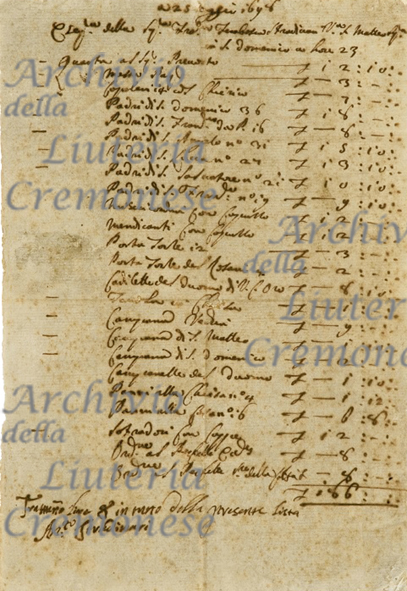
a 25 maggio 1698
Eseq[u]ia della Sig[no]ra Francesca Ferabosca Stradivari V[icinanz]a S. Matteo Sep[ol]ta in S. Domenico a hore 23.
Quarta al Sig. Prevosto L. 12,10
Messa Par[rocchia]le L. 3
Capelani 14 ed 1 chierico L. 7
Padri di S. Domenico 36 L. 18
Padri di S. Franc[es]co da P[adri] 16 L. 8
Padri di S. Angelo n° 31 L. 15,10
Padri di S. Lucca n° 27 L. 13,10
Padri di S. Salvatore n° 21 L. 10,10
Padri di S. Fran[ces]co n° 19 L. 9,10
Misericordini Con Capuccio (?) L. 12
Mendicanti Con Capuccio (?) L. 12
Porta torce 12 L. 3
Porta torce del Rosario 4 L. 2
Cadiletto del duomo di V[elluto] C[on] oro L. 8,10
Tavola in Chiesa L. 1
Campana Vechia, L. 9
Campana S. Matteo L. 1,10
Campana di S. Domenico L. 2
Campanelle del Duomo L. 1,10
Panni alla Chiesa n° 4 L. 1,12
Panni alla Casa n° 16 L. 6,8
Sotradori Con Cappa L. 12
Ord[i]ne al prefetto Ecc[lesiasti]co L. 8
Ord[i]ne del Prefetto l[ai]co della città L. 8
Totale L. 186
(Postilla autografa di Stradivari)
Tratten[u]to L. 8 in tutto della presente lista.
Ant.° Stradivari
«Signed by Antonio Stradivari – 1698 – CCS.GF– 1930
List of expenses relating to the funeral of Stradivari’s first wife, with the signature of Stradivari dated 25 May 1698
Ink on paper
B mm 251; H mm 171
‘Deduced 8 lire in all from the present list / Antonio Stradiveri’.»
The Legend preceding the Catalog does not mention the acronym CCS, which however can be intuitively presumed to mean Count Cozio di Salabue, as GF corresponds to Giuseppe Fiorini; the two acronyms indicate the origin of the document.
The document translated into English was made known for the first time by the Hills in 1902,[2] who undoubtedly cited it at the suggestion of Alfonso Mandelli, who said in his book published in 1903 that he himself «found it in the files of the "Fusequies ordered by the Ecclesiastical and Lay Prefects of 1698”, existing in the Archives of the Municipality of Cremona.»[3]
The photograph of the document, taken by the Cremonese photographer Ernesto Fazioli (the original is today preserved in the Image Archives of the Lombardy Region[4]), it appears to have been first published in 1929[5] and then again in 1932.[6] The document was then cited and transcribed in 1937 by Bacchetta,[7] and republished together with the image of Fazioli with the caption of the location of the document in the "Stradivarian Room of the Civic Museum - deposit from the Municipal Historical Archive".[8]
In 1972 Sacconi indicated the object at no. 601 of his catalogue, publishing only the photograph of Stradivari's autograph inscription:[9] while Santoro, in 1987, wrote: «The document was arbitrarily removed, decades ago, from the State Archive of Cremona, the Municipality Archive, the "Esequie" fund, a.1698, and transferred to the Civic Museum among the relics Stradivarians, now in the "Stradivari Museum».10] In the 1987 and 2001 catalogs of the Stradivaria Museum published by Electa, the card is numbered 601 and accompanied by a photograph, with the indication of its provenance from the "G. Fiorini Collection".[11] In 2008 Chiesa and Rosengard mentioned it, indicating its provenance from the Municipal Historical Archive,[12] while Pollens, publishing the photograph and transcription in 2010, limited himself to listing the previous bibliography.[13] In 2015 D'Agostino confirmed the authenticity of Stradivari's autograph annotation.[14]
At this point, it is clear that the indication of the origin of the paper from the Fiorini Collection originated with the 1987 catalog and the reiteration of the error in the 2016 catalog was made despite the fact that, in the SIRBEC (Regional Information System of Cultural Heritage) of the Lombardy Region, compiled two years earlier, had been correctly written in the "Historical-critical news" that: «The document was preserved in the Archives of the Municipality of Cremona, in the collection entitled "Funeral services ordered by the Ecclesiastical and Lay Prefects of 1698". In 1937 it was already exhibited in a display case in the Stradivarian Hall of the Civic Museum.»[15]
In short, the document had been found by Mandelli in the Municipal Historical Archive, in the folders containing the paper files of documents relating to the FUNERALS (1664-1782) which, as stated in the Inventory of the Municipal Historical Archive, now preserved in the Archive of the State of Cremona,[16] lists of expenses incurred for the funeral of various citizens are listed. In particular, the Stradivarian document had to be placed in b. 3, 2 “1698. n. 125. Francesco Bassi Prefect of the city's funeral", from which it should have been taken in 1937, in conjunction with the celebrations for the two hundredth anniversary of the death of Antonio Stradivari, to be exhibited in the Stradivari Hall of the Civic Museum.
2) A clarification also requires the provenance of the object described in the 2016 Catalog as follows:
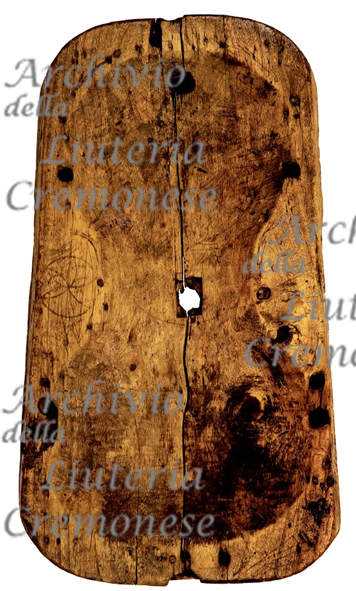
«MS 59
A. Stradivari AM-CT [Andrea Mosconi – Carlo Torresani 1987] – G.B.C. [Andrea Mosconi – Carlo Torresani 1987] 1893
Counterform for curving and finishing the top and back plates
Poplar
B mm 395; H mm 200
In the 1903-14 inventory we find a "violin-holder in wood with a shape in the form of the violin", the description is not very clear but and raises some doubts as to the origin of the artefact (workshop of AS [Antonio Stradivari] or EC [Enrico Ceruti]?)».
The Rubrica Y a – Liutai listed the object with the n. 130, with the provenance from the “Dono Cerani Gio.”,[17] that is, the donation of the funds from Enrico Ceruti's workshop to the Municipality of Cremona.
To remove any doubt it is useful to compare the photograph of the object shown in the 2016 Catalog with a photograph (probably by Ernesto Fazioli) published in 1937 in a French magazine,[18] in which you can still see the rectangular label of the 1903-14 Inventory (Rubrica Y a – Liutai), on which the no. must have been written. 130.
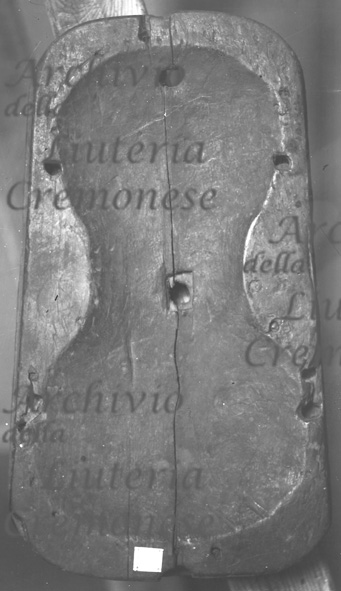
This label also appears in the same position in two other previous photographs:
- the first, taken by Aurelio Betri on 6 March 1900, shows the counterform fixed to a circular support hanging above a display case in one of the Halls of Violin Makers and Musicians of the Civic Museum, set up in Palazzo Ala-Ponzone on the initiative of Alfonso Mandelli since 1893;[19]
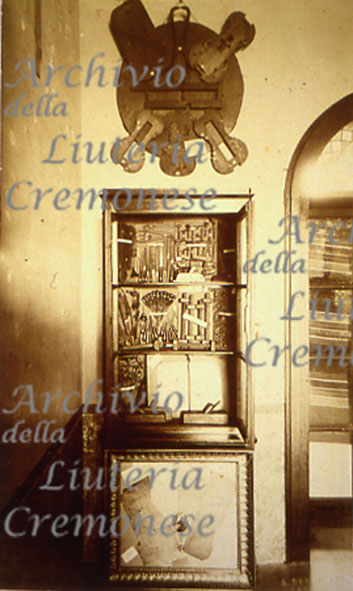
- the second, by Ernesto Fazioli, shows a display case from the Civic Museum, in the new headquarters of Palazzo Affaitati (1927), in which other finds received by the Municipality before 1930 were exhibited. It was published in 1929, together with a single photograph of the object with the caption “Form belonged to Stradivari”.
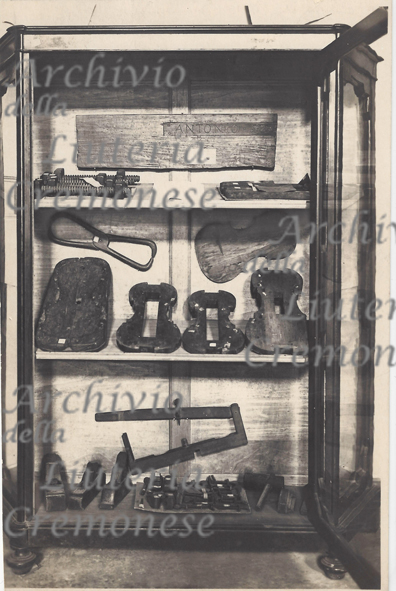
In 1972 Sacconi had cataloged the object as “N. 59. Counterform of A. Stradivari in poplar wood, cm. 39.5 x 20” without giving reasons for its attribution to Stradivari,[20] but in the 1987 Stradivari Museum catalog the object was correctly indicated as a "gift of G. B. Cerani".[21]
In fact, the acquisition of the object is certain through the donation of relics from the workshop of Giovanni Battista Ceruti made to the Municipality of Cremona in 1893 by Giovanni Battista Cerani, who raised the possibility that some objects from Stradivari's workshop were included. he did not indicate which ones. Therefore, the belief accepted in 1929, in some way replicated to this day, is not supported by any documentary and/or scientific evidence.
3) The find presented in the 2016 catalog with number MS 511 also requires clarification:
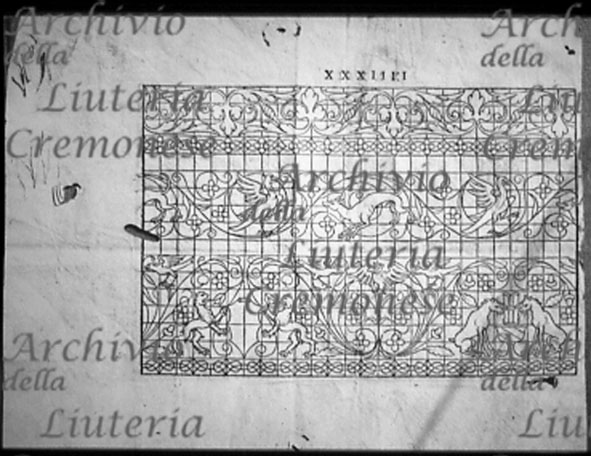
«Page from a book with decorative motifs
Paper
LR mm 180; H mm 30
PS 551»
In the 1956 inventory, compiled for the delivery of Cremonese violin making relics to the Scuola Internazionale di Liuteria, the object (n. 551) was generically included in a group of "inlay drawings".[22] In 1972, Sacconi described it at no. 511 of his catalog as «Book page of cm. 18 x 15.2 reproducing decorative motifs, to which Stradivari referred for the inlay of the “Greffuhle” violin of 1709, so called due to the griffin inserted in the decoration.»[23] The 1987 Catalog specified that they were "«Pages XXXIII and XXXIII from a book of patterns for decorations. The griffin referred to on page XXXIII was used by Stradivari for the inlay of the Greffuhle violin.»[24]
It was Stewart Pollens who reported the book from which the page had been torn, indicated in the first edition of 1567,[25] although we cannot be certain that the sheet preserved in Cremona comes from the first edition of the book by Giovanni Ostaus, entitled: La vera perfettione del disegno di varie sorti di ricami: & di cucire ogni sorte di punti à fogliami, punti tagliati, punti à fili, & rimessi, punti incrociati, punti à stuora, & ogn'altra arte, che dia opera à disegni, or from one of those printed subsequently in Venice until 1591.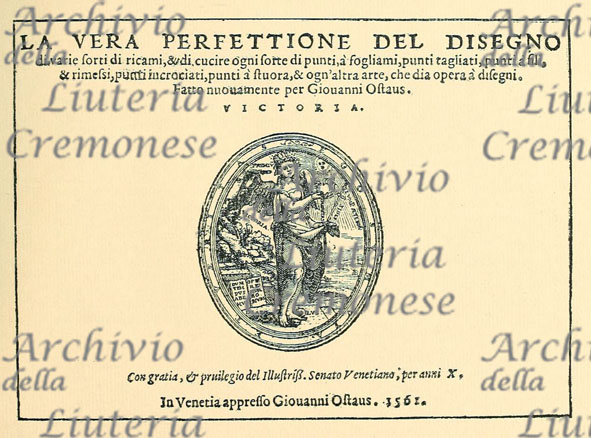
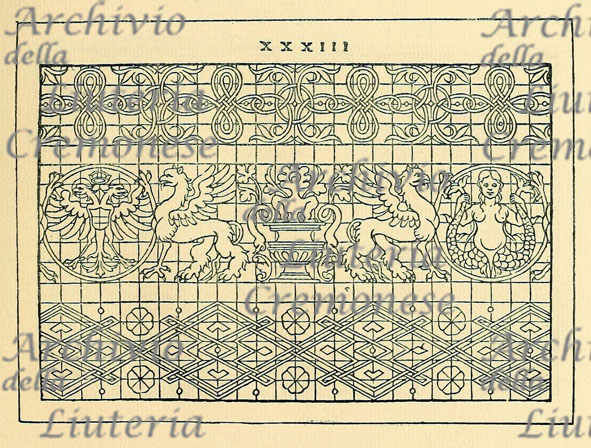
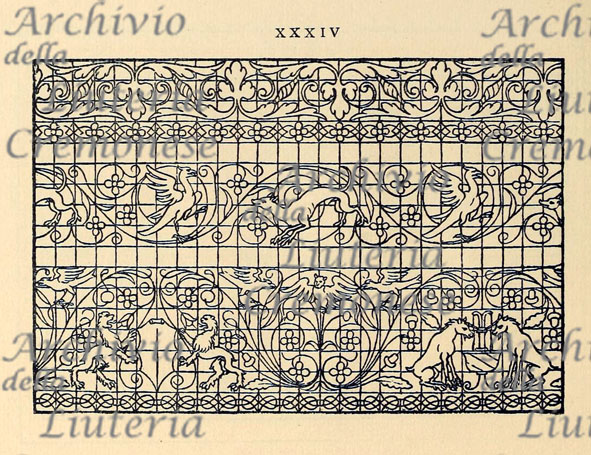
The acquisition by the Museum of Cremona is due to the 'Perpetual Deposit' of 1930 by Giuseppe Fiorini and the succession of changes of ownership must therefore be indicated as follows: Antonio Stradivari, Francesco Stradivari 1737; Paolo Stradivari 1743, Antonio II Stradivari 1775; Ignazio Alessandro Cozio Count of Salabue 1775; Matilde Cozio Countess of Salabue 1840; Marquis Giuseppe Rolando Dalla Valle 1853; Alessandro Lelio Maria Dalla Valle 1881; Paola Guidobono Cavalchini Roero Sanseverino widow Dalla Valle 1905; Giuseppe Fiorini 1920, Municipality of Cremona 1930.
4) The description of this object in the 2016 Catalog is as follows:
«MS 710
? Emanuele Piazza 1890
Fragment of an old chest or signboard with with painted decorations
Conifer wood
The name of Antonio Stra.. is inscribed on a portion of the wood
Spruce
LN 600 mm; LR mm 180; SP 20 mm
The artefact was found in Antonio Stradivari’s house, which was situated in Piazza S. Domenico, during restoration works.» [xxvi]
In the aforementioned “Rubrica Y a – Liutai” compiled between 1903-14, the object was described under the heading “Stradivari” as follows: «35 │ Painted wooden tablet; fragment of bench (back) with another piece of wood stuck in it with engraving: ANTONIO STRA │ Donated by the Soresina Piazza spouses.»[xxvii] While among the inventory cards preserved in the Civic Museum, probably compiled in preparation for the drafting of the Rubrica, under the heading "Different memories regarding Stradivari, famous violin maker from Cremona", we find the following more extensive description: «3. Fragment of a wooden bench back (eighteenth century), with a wooden strip inserted bearing the engraved writing ANTONIO STRA (found in the former Stradivari house in Piazza Roma, when the house itself was transformed to incorporate it into the Caffè Soresini (lath also painted remaining ..., approximately 19 cm high x 70 cm wide, described in the book “Nuove Indagini su Antonio Stradivari” by A. Mandelli, published by Hoepli Milano 1903 on page 120. Donated by the Soresini Piazza family circa 1889-1890.»
In fact, on 1 June 1888, Emanuele Piazza had bought the former Stradivari house from the widow of the tailor Gaetano d'Orleans, Carolina Cabrini, on whose façade the City Council had decided on 6 May prior to the installation of a plaque marble in memory of the famous luthier. The new owner of the building, with municipal authorization, immediately began – based on a design by the architect Vincenzo Marchetti († 1894) – the renovation of the building to incorporate it into the adjacent "Soresini" café/restaurant. The works, completed in 1891, gave neo-Renaissance style architectural unity to all the buildings involved, but made the internal and external features of Stradivari's house disappear forever. It was evidently during the demolition work in the former Stradivari house that Mr. Soresini, father-in-law of Emanuele Piazza, saved the fragment of the arcibanco from the hands of the bricklayers who were burning it and it was then donated by the Soresini-Piazza spouses to the Civic Museum, in which it is visible - in the photograph by Aurelio Betri dated 6 March 1900 - in installation of Palazzo Ala Ponzone.[28]
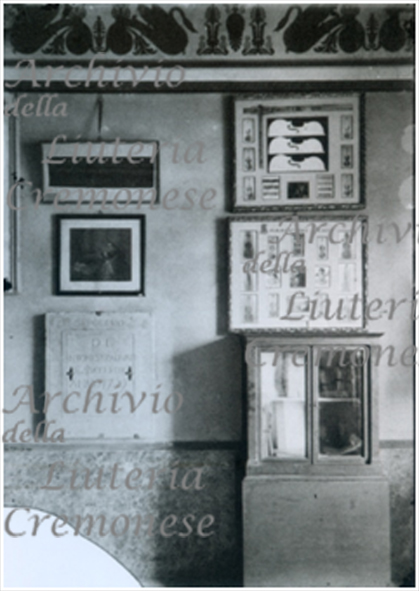
The Hills mentioned the object in 1902,[29] but it was Alfonso Mandelli, a contemporary of the facts and of the participants in the affair (well aware of the historicity of the building they were demolishing!), who testified in his 1903 book that the clapboard showed remains of a painted decoration (volutes of yellow foliage and remains of the plaque of a coat of arms), also recalling that Antonio II Stradivari, in a letter sent on 21 November 1775 to the intermediaries of Count Cozio di Salabue, had spoken of ""various other models of instruments found closed in a casabanco",[30] the same one who, reduced to a plank, ended up as we have seen, first sheltering a ceiling, then heating the bricklayers' polenta.»[31]
5) The three metal thickness gauges listed in the 2016 catalog on pages 248 and 249 deserve a final consideration:

«MS 661
Stradivari workshop? – CCS-GF? – 1930?
Tickness calliper
Metal
LN mm 236»
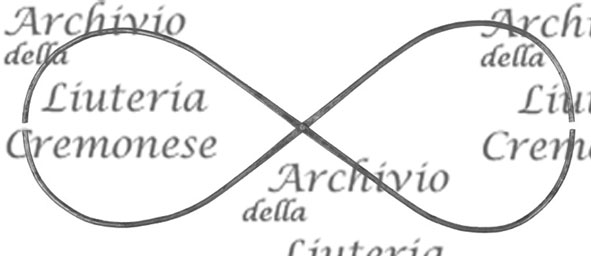
«MS 662
Stradivari workshop? – CCS-GF? – 1930?
Tickness calliper
Metal
NL mm 281»
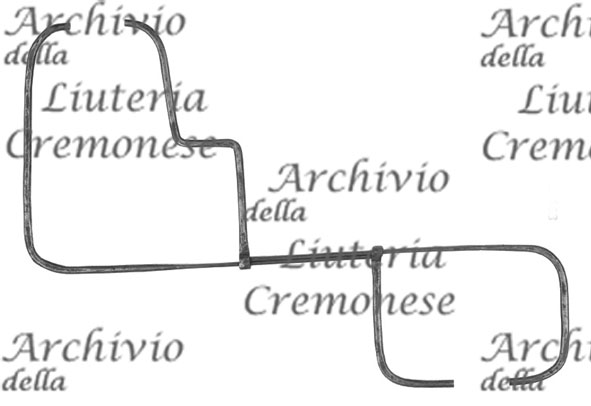
«MS 663
Stradivari workshop? – CCS-GF? – 1930?
Tickness calliper
Metal
NL mm 289»
Before the three objects were purchased by Giuseppe Fiorini and reached the Museum of Cremona, objects nos. 661 and 663 were illustrated, with the relevant images, as "Stradivari calipers for adjusting thicknesses" in the Hill book of 1902[xxxii] and, later, all three by Sacconi in 1972 who described them as "Thickness gauges for interiors in tempered iron..., for checking the thicknesses of soundboards and bottoms", but showing only the images of numbers 662 and 663.[33] The 1987 Mosconi-Torresani Catalog showed only the image of no. 663 and described the three objects as follows: “Antonio Stradivari. Three feeler gauges of different shapes and sizes. They were used to control the thicknesses of the backs and soundboards.”[34] Finally, Pollens described the three objects simply as "Thickness calipers used by Antonio Stradivari", showing images of the numbers 662 and 663.[35]
Cacciatori, as seen above, expressed doubts (?) about their provenance from Stradivari's workshop and from the Cozio di Salabue/Giuseppe Fiorini collection.
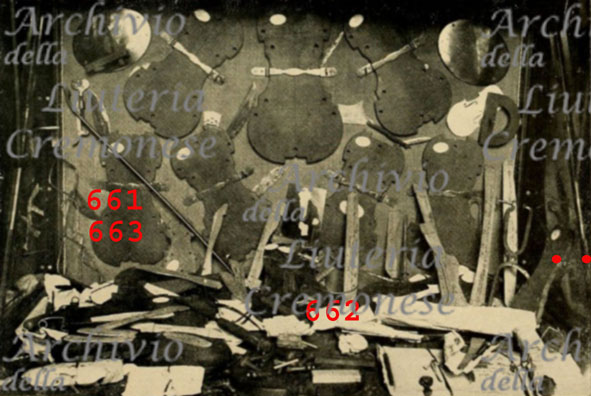
But there is no doubt that the three objects were part of Giuseppe Fiorini's Deposit, given that they can be seen, on the left and in the centre, in the photograph of the display case of the forms of the Cozio di Salabue/Dalla Valle Collection exhibited in Milan in 1881; but the attribution made in the past to Stradivari's workshop actually raises questions.
We must ask ourselves whether similar tools were necessary for Stradivari (as for any luthier) during the construction of the instruments, since every part of them was directly accessible to him and could be measured without obstacles with other tools.
These thickness gauges give the possibility of "checking the thicknesses of the soundboards and backs" of entire instruments and it therefore seems more logical to consider that they could be devices built by Count Cozio di Salabue to carry out the measurement of the instruments in his collection, undertaken as part of his project for a treatise on Cremonese violin making, which he began but did not complete.
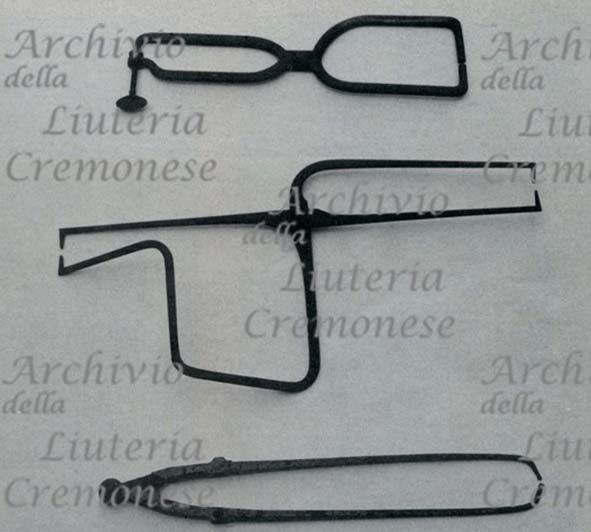
The same function and origin of the three feeler gauges in the Cremona Museum could also include other objects, of larger dimensions, depicted in the catalog of an exhibition curated by the Florentine luthier Carlo Vettori in 1989 and attributed, without indicating their provenance, to Stradivari's workshop.[36]
In fact, a tool similar to the one at the top of this photograph can be seen, on the right, in the photograph of the aforementioned display case of the Dalla Valle Collection from 1881. If it were the same object, however, it would be necessary to clarify how these objects remained out of storage at the Museum of Cremona made by Giuseppe Fiorini in 1930.
Gianpaolo Gregori
April 18, 2024
[1] Cacciatori Fausto (redactor), Antonio Stradivari. Disegni modelli forme, Cremona, Museo del Violino, 2016
[2] Hill, W.E - Hill, A.F. - Hill, A.E., Antonio Stradivari. His Life and Work (1644-1737), London, Hill & Sons,
1902, p. 16.
[3] Alfonso Mandelli, Nuove indagini su Antonio Stradivari, Milan, Hoepli,1903, p. 38.
[4] https://www.lombardiabeniculturali.it/fotografie/schede/IMM-LOM60-0033817/?view=autori&offset=1550&hid=3573&sort=sort_date_int
[5] Bonetti Carlo-Cavalcabò Agostino-Gualazzini Ugo, «Alla ricerca delle origini di A. Stradivari», in: Cremona, Cremona, Cremona Nuova, february 1929, p. 13.
[6] Bonetti Carlo, «Gli antenati di Antonio Stradivari», in: Cremona, Cremona, Cremona Nuova, april 1932
[7] Bacchetta Renzo, Stradivari non è nato nel 1644, Cremona, Cremona Nuova, 1937, p. 40.
[8] Bonetti Carlo-Cavalcabò Agostino-Gualazzini Ugo, Antonio Stradivari. Notizie e documenti, Cremona, Archivio Storico Cremonese, 1937, p. 57.
[9] Sacconi Simeone Fernando, I "Segreti" di Stradivari, Cremona, Libreria del Convegno,1972, pp. 248 e 251, fig. 182.
[10] Santoro Elia, Antonius Stradivarius, Cremona, 1987, p. 127, nota 9.
[11] Andrea Mosconi-Carlo Torresani, Il Museo Stradivariano di Cremona, Milano, Electa, 1987, p. 100; Andrea Mosconi-Carlo Torresani, Il Museo Stradivariano di Cremona, Milano, Electa, 2001, p. 129.
[12] Chiesa Carlo-Rosengard Duane, The Stradivari Legacy, Londra, Peter Biddulph, 2008, p. 49, nota 56.
[13] Pollens Stewart, Stradivari, Cambridge University Press, 2010, p. 24-25.
[14] D’Agostino Marco, La scrittura di Antonio Stradivari, Cremona, Edizioni Del Miglio, 2005, p.38.
[15] See: file:///C:/Users/User/Downloads/OARL_CR210-00015%20(2).pdf
[16] See: Valeria Leoni (a cura di), Archivio di Stato di Cremona, Inventario dell’archivio storico del Comune di Cremona, Sezione di Antico Regime (secc. XV-XVIII), Trezzano sul Naviglio, Edizioni Unicopli, 2009, p. 466.
[17] See: Gianpaolo Gregori 2. Gli inventari dei cimeli liutari di Cremona, in: http://www.archiviodellaliuteriacremonese.it/monografie/inventari_cimeli_liutari_cremona.aspx, 2014
[18] Gerard Jean P., «Stradivarius», in: Le monde illustré, Parigi, Jule 31, 1937, p. 527
[19] See: Caccialanza Roberto, Immagini della vecchia Cremona nelle Lastre Betri. Il fondo fotografico antico della Biblioteca Statale di Cremona, Collana Mostre, Vol. XXXIV, Catalogo della mostra, Cremona, Fantigrafica, 2017, pp. 68-69.
[20] Sacconi Simone Fernando, I "Segreti" di Stradivari, Cremona, Libreria del Convegno, 1972, p. 199.
[21] Andrea Mosconi-Carlo Torresani, Il Museo Stradivariano di Cremona, Milano, Electa, 1987, p. 42
[22] Gianpaolo Gregori 2. Gli inventari dei cimeli liutari di Cremona, in: http://www.archiviodellaliuteriacremonese.it/monografie/inventari_cimeli_liutari_cremona.aspx, 2014
[23] Sacconi Simone Fernando, I "Segreti" di Stradivari, Cremona, Libreria del Convegno, 1972, p. 246.
[24] Andrea Mosconi-Carlo Torresani, Il Museo Stradivariano di Cremona, Milano, Electa, 1987, pp. 94-95.
[25] Pollens Stewart, Stradivari, Cambridge University Press, 2010, p. 272-274.
[26] Cacciatori, cit., p. 256
[27] Gianpaolo Gregori 2. Gli inventari dei cimeli liutari di Cremona, in: http://www.archiviodellaliuteriacremonese.it/monografie/inventari_cimeli_liutari_cremona.aspx, 2014
[28] Vedi: Caccialanza Roberto, Immagini della vecchia Cremona nelle Lastre Betri. Il fondo fotografico antico della Biblioteca Statale di Cremona, Collana Mostre, Vol. XXXIV, Catalogo della mostra, Cremona, Fantigrafica, 2017, pp. 68-69.
[29] Hill, W.E - Hill, A.F. - Hill, A.E., Antonio Stradivari. His Life and Work (1644-1737), Londra, Hill & Sons, 1902, fig. 6.
[30] Trascrizione in: Bacchetta Renzo, Stradivari non è nato nel 1644, Cremona, Cremona Nuova, 1937, p.92. L’originale è conservato a Cremona, Biblioteca Statale. Civico, Cozio, Cozio 89, carta 13v; vedi: https://www.internetculturale.it/jmms/iccuviewer/iccu.jsp?id=oai%3Awww.internetculturale.sbn.it%2FTeca%3A20%3ANT0000%3AN%3ACNMD0000244571_1&mode=all&teca=MagTeca+-+ICCU
[31] Alfonso Mandelli, Nuove indagini su Antonio Stradivari, Milano, Hoepli,1903, p…..
[32] HILL, cit., 1902, pp. 183 e 187
[33] SACCONI, cit., pp. 70 e 249
[34] MOSCONI-TORRESANI, cit., pp. 104-106
[35] POLLENS, cit., pp. 250-252
[36] Carlo VETTORI (a cura di), Liuteria italiana: principali scuole antiche e moderne, Borgo San Lorenzo, Comunità Montana Zona E, 1989.